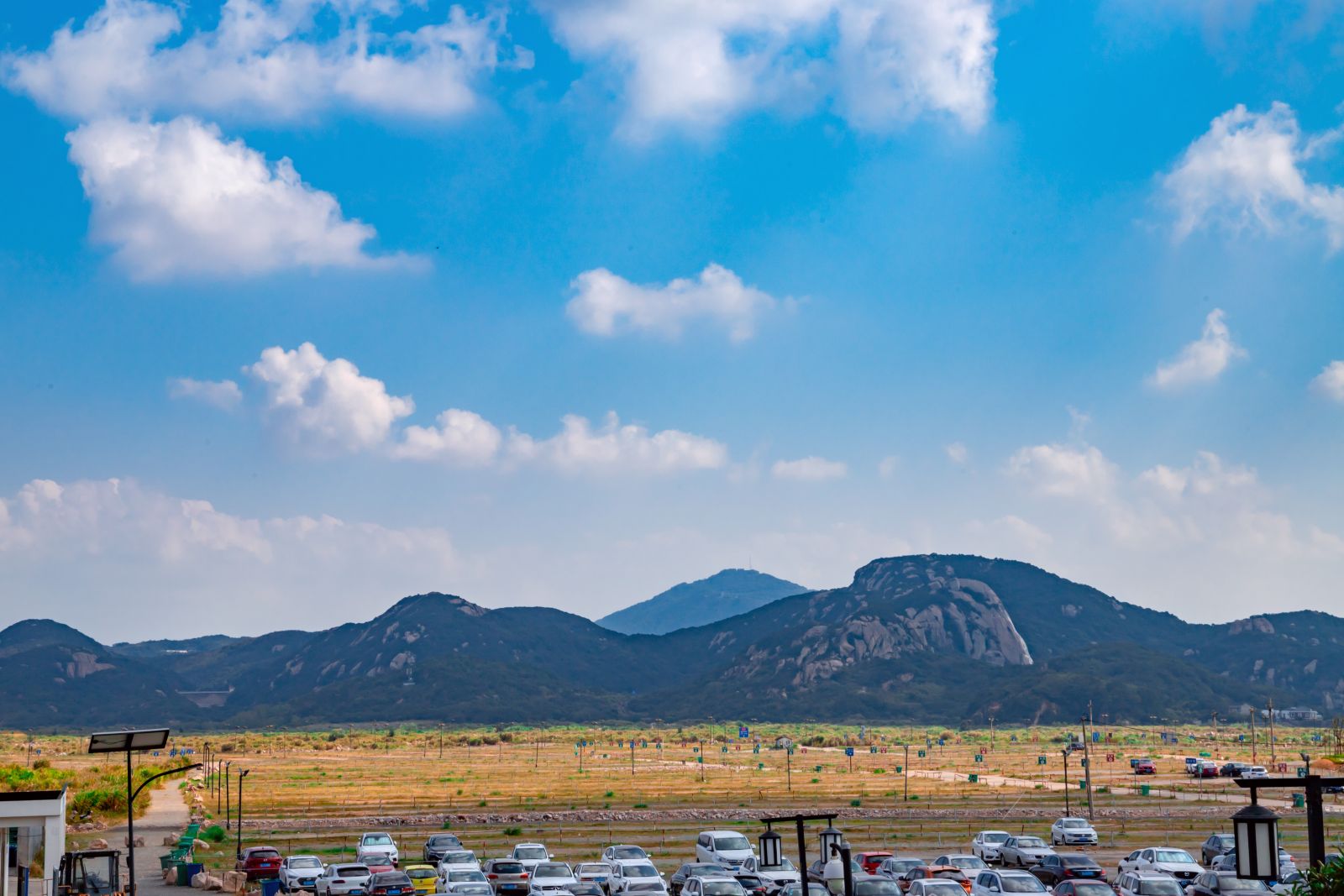Chinese Name: 普陀山 Pronunciation: Pǔtuó Shān
Suggested Visiting Hours: 1-2 Days
Best Visiting Seasons: Spring and Autumn
Occupied Area: About 12.5 square kilometers (4.8 square miles)
Address: No. 1, Meicen Road, Putuo District, Zhoushan City, Zhejiang Province, China
| Tourists | Ticket Price | |
| Peak Season (February to November) |
Low Season (December to January) |
|
| Adults | 160 yuan | 120 yuan |
| Children (aged 6-18 and 1.2-1.5 meters) |
80 yuan | 60 yuan |
| Seniors (aged 60-69) |
||
1. Admission ticket price during the first day to the fifth day of the first lunar month, May 1st to 3rd, October 1st to 5th: 180 yuan
2. Mount Luojia Scenic Area ticket price: 18 yuan
3. Mount Putuo Island is not connected to the outside world by road, so visitors need to take a boat to Mount Putuo Island.
4. You can buy admission tickets together with the boat ticket (30 yuan for entry and exit respectively).
5. Tickets for Mount Putuo do not include temple tickets and Mount Luojia Scenic Area tickets.
Children under 6 years old or 1.2 meters and senior citizens over 70 years old with valid certificates are free of charge.
| Attractions | Time (All Year) |
| Mount Putuo Opening Hours | 6:50 - 21:50 |
| Temples Opening Hours | 6:00 - 18:00 |
1. No entry is allowed after 21:50.
2. Temples may have different opening hours, and the specific hours are subject to the notice of the attractions on the day of visit.
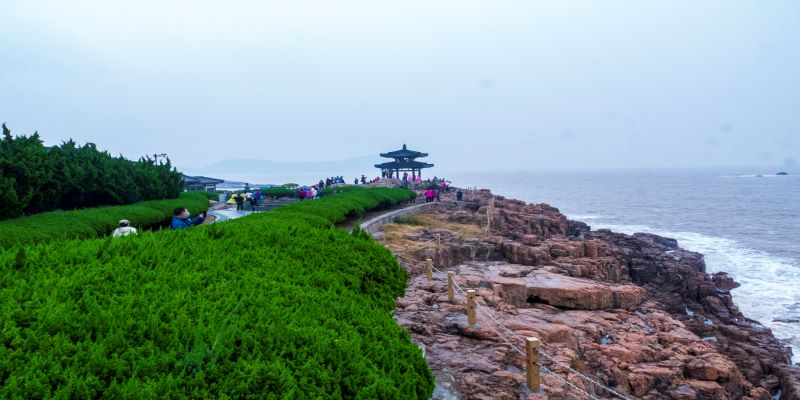
Mount Putuo has been a pilgrimage place for over a thousand years. As a Buddhist resort, Mount Putuo Scenic Area has three main attractions: the Puji Temple, the Fayu Temple, and the Huiji Temple. The three major Buddhist temples are typical of the temple complex in the early Qing Dynasty (1636-1912) in China. There is also a 33-meter-high statue of Guanyin at Purple Bamboo Forest on Mount Putuo, which is a sight that tourists will not want to miss. It is very enjoyable to stroll around the Thousand Pace Beach and overlook the reclining Buddha on the sea.
Mount Putuo is a natural paradise for wild animals and is also known as the “Island Botanical Garden” with lush trees. A series of festival activities are held here, among which the grandest tourist festival is the Nanhai Guanyin Cultural Festival. It is a Buddhist tourism event with the connotation of promoting Guanyin culture and creating culturally famous mountains.
According to historical records, Mount Putuo was the treasured land of Taoist cultivation as early as more than 2000 years ago. The name of Mount Putuo has changed several times.
In 1080, people from Japan, South Korea, and other countries came to China to do business, and they also began to climb the mountain to worship Buddha, and Mount Putuo gradually became famous.
In 1131, Mount Putuo became the pure land of Buddhism.
In 1214, the imperial court of the Southern Song Dynasty (1127-1279) designated Mount Putuo as the dojo enshrining and worshiping Guanyin.
In 1605, the Baotuo Guanyin Temple was bestowed as the “Putuo Buddhist Temple for the Protection of the Country and Eternal Life”. Since then, the mountain was named Mount Putuo.
In April 1979, Mount Putuo Administration Bureau was established, and the government allocated funds and materials to restore the scenic spots.
In 1982, Mount Putuo was rated as a national key scenic spot.
In 1983, it was designated by the State Council as a national key Buddhist temple of the Han nationality.
In 2004, Mount Putuo was rated as ISO14000 National Demonstration Zone.
On May 8, 2007, Mount Putuo Scenic Area was officially approved as a national 5A tourist scenic area.
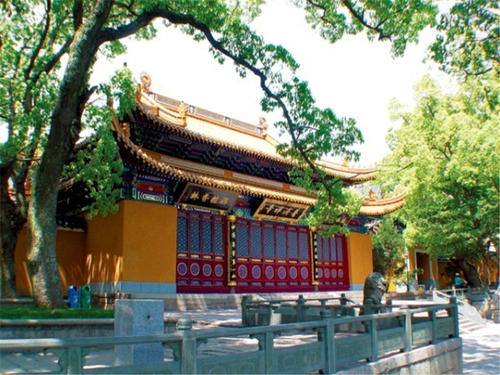
The Puji Temple, the largest Buddhist temple in Mount Putuo, is also the main temple enshrining Guanyin (Guanyin or Avalokitesvara represents the virtue of great compassion. People enshrine Guanyin to remind themselves that we should treat people and things like Guanyin with compassion and great love). The temple is known as the “Front Temple” since it is located on the southern foot of Lingjiu Peak. The Puji Temple is the center of Buddhism activities on Mount Putuo, and all major Buddhist events are held here.
The Puji Temple features uniqueness in layout, and architectural design. It is the representative of the Chinese temples, and it is also an important relic of the official architecture of the Qing Dynasty in Zhejiang. Thus, the Puji Temple embodies high historical, cultural, and artistic value.
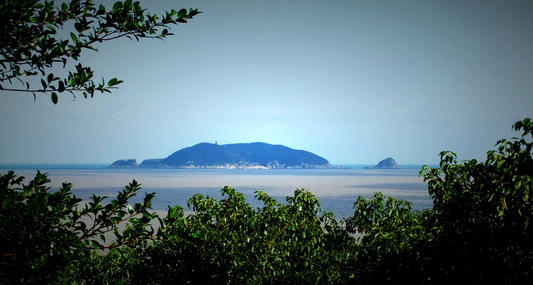
Mount Luojia is a small island to the southeast of Mount Putuo. It is said that Mount Luojia is the holy place for Guanyin to practice Buddhism. Enjoying the name “Sleeping Buddha on Sea”, Mount Luojia is as famous as Mount Putuo, so it is also called “Putuo Mount Luojia” historically.
Mount Luojia Island covers an area of 0.4 square kilometers with attractions of Miaozhan Pagoda. Since ancient times, people have often said, “Anyone who worships Mount Putuo must go to Mount Luojia” and “If you don’t reach Mount Luojia, you will not be counted as finishing visiting Mount Putuo.” Mount Luojia also features one of the twelve views of Mount Putuo.
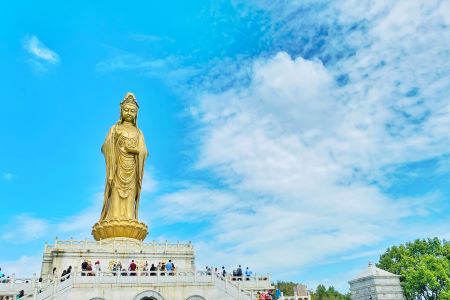
Nanhai Guanyin Statue was built in 1997, which added brilliance to the cultural landscape of the rich Buddhist cultural atmosphere. This statue of Guanyin has a total height of 33 meters, of which the base is 13 meters high. The bronze statue is 18 meters high, and the lotus platform is 2 meters.
Nanhai Guanyin Statue stands on the Longwan Hill at the southern end of Mount Putuo, making the place significant together with the hills. Nanhai Guanyin Statue also attracts numerous tourists, so it makes the incense flourishing all year round. Nanhai Guanyin Statue can be regarded as a symbol of the Haitian Buddha Kingdom.
Take a shuttle boat or speedboat from Shenjiazhuang to the Guangfu Temple → Mount Putuo → Purple Bamboo Woods → Nanhai Guanyin Statue → Puji Temple → Haiyin Pond → Yubei Pavilion → Duobao Pagoda → Xinzi Stone → Meifu Temple → Pantuo Stone → Guanyin Ancient Cave
Day 1: Zhoushan → Zhujiajian Island → Mount Putuo → Puji Temple → Fayu Temple → Thousand Pace Beach
Day 2: Puji Temple → Purple Bamboo Forest → Chaoyin Cave →Nanhai Guanyin Statue
Go to the ropeway station and take the ropeway to Huiji Temple → Fayu Temple → Puji Temple → Purple Bamboo Woods → Nanhai Guanyin Statue
1. Mount Putuo is a sacred place of Buddhism. It is necessary to respect Buddhist beliefs and behave appropriately.
2. It is not allowed to take pictures in all temples.
3. There is currently no on-site ticket purchases in the scenic area. Tourists must go to the online platform for real-name ticket purchases one day in advance.
4. There will be more tourists on Mount Putuo on weekends and holidays. If conditions permit, try to travel off-peak.
Visitors need to take the ferry from Wugongzhi Dock at the neighboring Zhujiajian Island to Putuo Mountain Island. It takes about 10 minutes (15 yuan) to arrive at Mount Putuo.
Before you go to Mount Putuo, you need to go to the Zhujiajian wharf firstly and then take a ferry to Mount Putuo. So you can tell the taxi driver like this:
Chinese: 请带我去朱家尖码头。English: Please take me to Zhujiajian wharf.
If you go to Zhujiajian wharf from Zhoushan Putuoshan Airport, it takes about 5 minutes (about 10 yuan).
If you go to Zhujiajian wharf from Zhoushan Putuo Long-distance Passenger Transport Center, it takes about 15 minutes (about 20 yuan).
If you go to Zhujiajian wharf from the center of Zhoushan (Hilton Hotels Zhoushan), it takes about 15 minutes (about 20 yuan).
